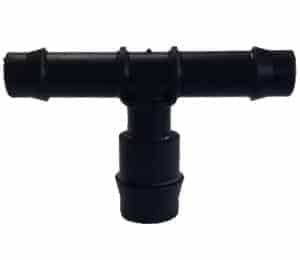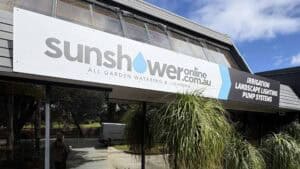Product Description
Use these Poly Increasing Tees to split one poly pipe into two lines or to add a extra poly pipeline of a larger size to an existing line.
The Poly fittings we offer are high quality Antelco fittings made especially for Low Density Poly and Drip Tube. Sunshower installs these fittings on all of our irrigation installations with poly pipe or drip tube.
Antelco Poly Tees (Increasing)
| Antelco Poly Tee 13mm x 19mm In stock SKU: FLB-TEE1319 |
$2.59 |
| Antelco Poly Increasing Tees 13mm x 19mm (bag of 20) In stock SKU: FLB-TEE1319/20 |
$36.19 |
Product Description
Use these Poly Increasing Tees to split one poly pipe into two lines or to add a extra poly pipeline of a larger size to an existing line.
The Poly fittings we offer are high quality Antelco fittings made especially for Low Density Poly and Drip Tube. Sunshower installs these fittings on all of our irrigation installations with poly pipe or drip tube.





Videos

Product Specifications
| Antelco Poly Tee 13mm x 19mm | Antelco Poly Increasing Tees 13mm x 19mm (bag of 20) | |
|---|---|---|
| Product Material | Poly | Poly |
| Product Colour | Black | Black |
| Product Inlet Pipe Size | 13mm Barb, 19mm Barb | 13mm Barb, 19mm Barb |
| Product Max. Inlet Pressure (kPa) | 400 | 400 |
| Product Type | Tee | Tee |
Customer Reviews
Low Density Poly (LDPE), Australian Made FAQs
The main cause of blowout is pressure. Whether it’s poly fittings, PVC fittings or timers, whatever the component, if the pressure is too high for what it’s designed for, kaboom! Simply solve the problem with a pressure reducer & make it a brass one if it’s on your water supply.
Low density poly fittings connect and branch low density polyethylene (LDPE) pipes in domestic garden and landscape irrigation systems. It’s not to be installed in constant pressure applications (eg: before irrigation valves), rather for lateral pipework in garden beds or lawns.
Low density fittings are an economical, easy to install option for non-constant pressure applications (often used in gardens and beds). While high density pipe & fittings suit constant pressure applications for mains or commercial systems, or even applications where durability & reliability are particularly important.
No, these fittings are intended only for low pressure applications (usually below 300kPa). Use high density fittings or PVC for higher pressure applications.
Cut the pipe square, push the fitting in fully, and use ratchet clamps or locking clips for a secure seal. Check for leaks before covering lines.
Yes, with the right threaded or barbed adapters, you can connect LDPE pipe to PVC, copper, or garden hose fittings.
Yes, our low density poly fittings are made from UV-stabilised materials for durability in all Australian outdoor conditions.
Poly pipe fittings connect, extend, or branch poly (polyethylene) pipes in irrigation systems, making them essential for building or repairing garden, lawn, or commercial watering setups. HDPE can be used for high pressure & even commercial applications, LDPE is suitable for small domestic, non-constant pressure applications.
We stock joiners, elbows, tees, adaptors, and more. For barbed low density poly, threaded high density poly, mechanical metric & rural fittings and electrofusion weld fittings. For all poly pipe sizes and applications.
Some yes, some no. Low density poly fittings are not suited to high pressure, whereas high density fittings can be used for both. Just be sure to check the pressure ratings before purchase and install.
Some poly pipe types & their fittings are certified for potable water, while others are irrigation-only. Always confirm certification in the product details if you need fittings for drinking water.
Yes, with the right threaded adaptors, you can connect poly pipe to PVC, copper, or threaded fittings. Browse our range of threaded fittings and adaptors for compatible solutions.
Yes, our poly fittings are made from UV-stabilised materials for long life and reliable performance in harsh Australian conditions.
Irrigation systems utilise a variety of pipes, each offering unique advantages. HDPE (high density poly) pipe is a popular choice due to its flexibility, durability and suitability for underground installation. Another standard option is the PVC pipe, valued for its corrosion resistance. Interestingly different parts of Australia, have their different preferences! For lateral pipework, LDPE (low density poly) is very popular for it’s workability & low cost. For applications requiring superior strength and durability, such as central water connections, brass fittings and valves are often preferred because they are highly resistant to corrosion and wear. Copper pipes, while less common in modern systems due to their higher cost, are still valued for their exceptional resilience from ground movement.
The size of piping depends on a number of factors, but the main one is the length of the run. Longer pipe lengths also necessitate larger diameters to minimise friction loss. Higher water pressure allows for smaller pipes, but excessively high pressure may require larger sizes to handle the force. Finally, the desired flow rate at the endpoint also influences the pipe size you’ll need. For more comprehensive assistance, please reach out to our experts.
Preventing leaks in your irrigation system starts with using the right fittings for your pipe type and adequately preparing the pipe ends for a secure connection. Apply thread tape to threaded fittings and appropriate sealant for solvent-welded connections. Tighten fittings securely, but avoid over-tightening. Regularly inspect your system for any signs of leaks to address potential issues promptly.
Yes, burying irrigation pipes underground is a common practice and offers several advantages. It protects the pipes from damage, reduces water evaporation and keeps them out of sight for a cleaner landscape aesthetic.
However, it’s crucial to choose the right type of pipe for underground installation. Polyethylene (poly) pipe is specifically designed for this purpose, thanks to its flexibility and durability. Always check local building codes and regulations for any requirements regarding underground pipe installation.
We offer a full range of fittings matched to various pipe materials and sizes. When joining from one material to another, a threaded connection is required. BSP threads are the Australian standard & that is what we sell here in Australia. Always check compatibility in the product description or ask our team for advice.
The process for repairing a leak varies depending on the type of pipe used. Often it involves cutting out the broken section, and rejoining with two suitable couplings or using a repair joiner. If threaded connections are involved, use thread seal tape and ensure seals are tight.
Potential causes include undersized pipe, leaks, blockages, or poorly fitted connections. Inspect the system, flush lines, and check for visible issues at fittings.
You might also need...
You might also like...
Need more help with Low Density Poly (LDPE), Australian Made ? Check out these handy resources from our Help Centre












